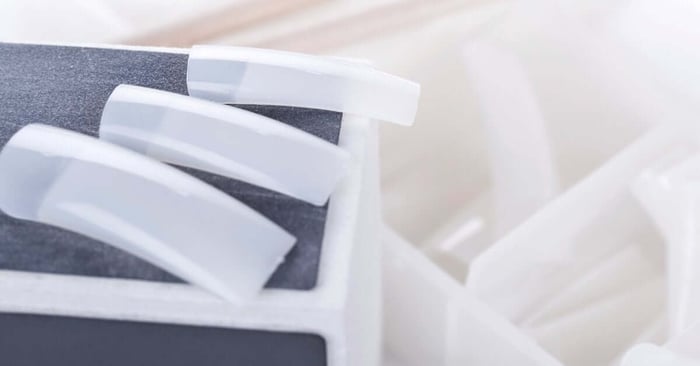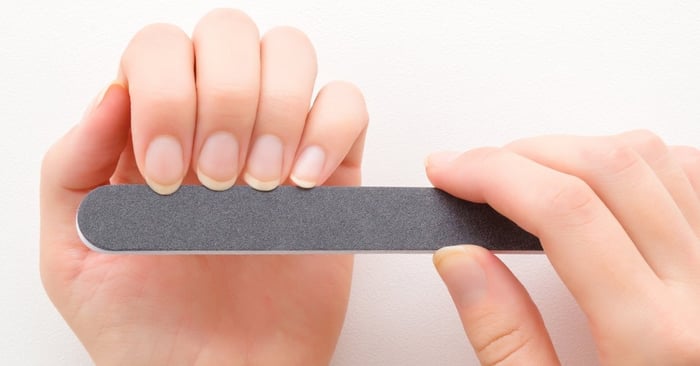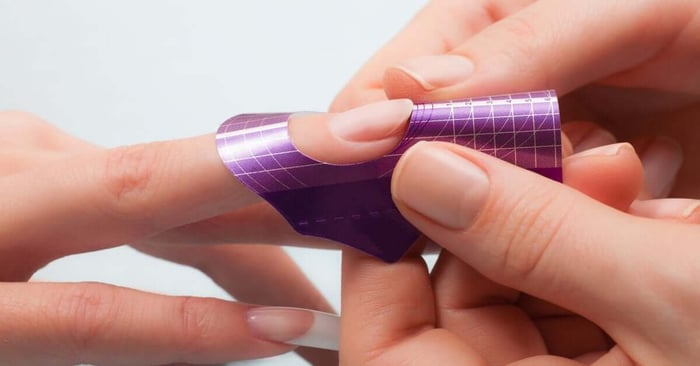When it comes to nail forms and tips, the one that’s better for building acrylics depends on the user’s preferences. Factors like nail strength, customization, and maintenance will determine the answer. Each method has advantages, and understanding the distinctions between nail forms and tips is key to choosing the approach best suited to your style, nail structure, and lifestyle.
Nail Forms
Experienced nail techs commonly prefer nail forms for their versatility and natural appearance. Technicians place the forms under the free edge of the nail, so the forms can serve as a base for sculpting acrylic or gel extensions.
Adjustable and ideal for irregular nail shapes, forms contour closely to the natural nail for a seamless finish. They’re great for custom shapes, like almond- or stiletto-shaped nails. However, the application takes skill and practice.
Application
The technician preps the natural nail by filing and cleansing it. Next, they place the nail form carefully beneath the free edge, following the curve of the natural nail. Lastly, the technician applies an acrylic powder or gel and sculpts the product into the desired shape. This gives the form a seamless, natural-looking outline.
Advantages
One advantage of nail forms is their ability to provide a natural, lightweight finish. Since forms don’t require attaching a rigid tip to the natural nail, the extensions feel more comfortable to the wearer. This method also minimizes the use of adhesives that can occasionally trigger allergies or irritate sensitive skin.
Another advantage includes their flexibility in creating customized extensions. Whether you’re after a dramatic flair or a subtle enhancement, nail forms can be shaped and styled to meet precise visions.
Nail Art Options
When it comes to artistic possibilities, both nail forms and tips are fantastic canvases. However, the customization opportunities make nail forms a standout choice for individuals who want classy, unique styles perfectly designed for their nail beds. Using forms allows nail artists to experiment with shapes, ombre blends, and textured patterns seamlessly.
Nail Tips
Nail tips are a classic, widely used method for acrylic extensions. A nail tip is a shaped plastic extension adhered to the natural nail using nail glue that’s overlaid with acrylic for reinforcement. The method is ideal for beginners or clients who prefer standard nail shapes and a slightly quicker application process.
Since nail tips are premade, they eliminate the complexity of sculpting from scratch. They are available in various shapes and lengths, such as square, round, or oval; users can trim and file the tips to their desired style. Professionals commonly recommend nail tips for individuals who struggle with uneven or bitten nails because tips provide an excellent base for enhancing the nails’ appearance.

Application
For nail tips, the process begins with nail cleansing and preparation. The technician bonds the tip onto the natural nail using glue, and they trim and file the tip to the desired length. An acrylic overlay seals the tip to the natural nail for added durability that will prevent lifting. While the application is generally faster than that of forms, precision in gluing and filing requires careful application for beautiful results.
Advantages
Nail tips offer a quick, beginner-friendly way to apply acrylics. Anyone who is new to extensions will favor the pre-shaped, easy-to-use nail tips. This product provides uniformity across all nails with minimal effort.
Tips also add strength to short or weak nails by reinforcing them with durable plastic. As a result, the wearers will have strong yet stunning nails without needing the high skill level that nail forms require.
Nail Art Options
Nail tips, although slightly more uniform in shape, are ideal for painting and embellishing with stickers, rhinestones, or other decorative elements. They are a favorite for premade seasonal designs or for people seeking picture-perfect consistency for events like weddings or photo shoots. Cover nude acrylic powder is an excellent product for both these techniques, enhancing the clarity and elegance of any nail art.
Which Style Is More Durable?
Durability is a concern when selecting nail forms or tips. Both can result in strong, long-lasting extensions when done correctly, but nail forms frequently edge out slightly in this category. With forms, the acrylic product wraps around the entire natural nail, creating a seamless bond that enhances the structure’s overall stability.
Nail tips, while strong, rely on the adhesive bond between the tip and the natural nail. This can sometimes create a weaker point of stress where lifting or breakage might occur if not reinforced with overlayed acrylic. Individuals who perform activities that involve heavy use of their hands may find nail forms more resilient in the long run.
Choose the Right Approach for Your Nail Type
The decision to go with nail forms or tips largely depends on a person’s nail type. Individuals with long natural nails benefit more from nail forms because there is an adequate base to build on. Forms are also ideal for clients with wide, flat, or irregular-shaped nail beds, as they are adjustable to fit unique contours perfectly.
Meanwhile, individuals with short or bitten nails may find nail tips to be the better option. Tips provide an immediate solution for creating length and shape, even when the natural nails are too short to support molded formations from a nail form. Alternatively, some clients opt for tips out of personal preference because of the faster application process.

Maintenance and Longevity Considerations
Regular fills are necessary every two to three weeks as the natural nails grow out. Nail forms have no glued-on components that could potentially lift, so they aren’t as high maintenance as nail tips. In comparison, nail tips may require extra attention to the area where the tip meets the natural nail; improper filing or gluing can lead to gaps or lifting over time.
Final Thoughts
Choosing between nail forms and nail tips for building acrylics depends on the client’s style, nail health, and preferences. Forms offer customization and a natural look, while tips provide quick, consistent results. Both deliver salon-quality finishes when applied by skilled technicians.
A great way to find out what you like is to try both acrylic nail methods. Make a note of the features you like and dislike. From there, you can select the best fit for your nail type, lifestyle, and beauty goals.

